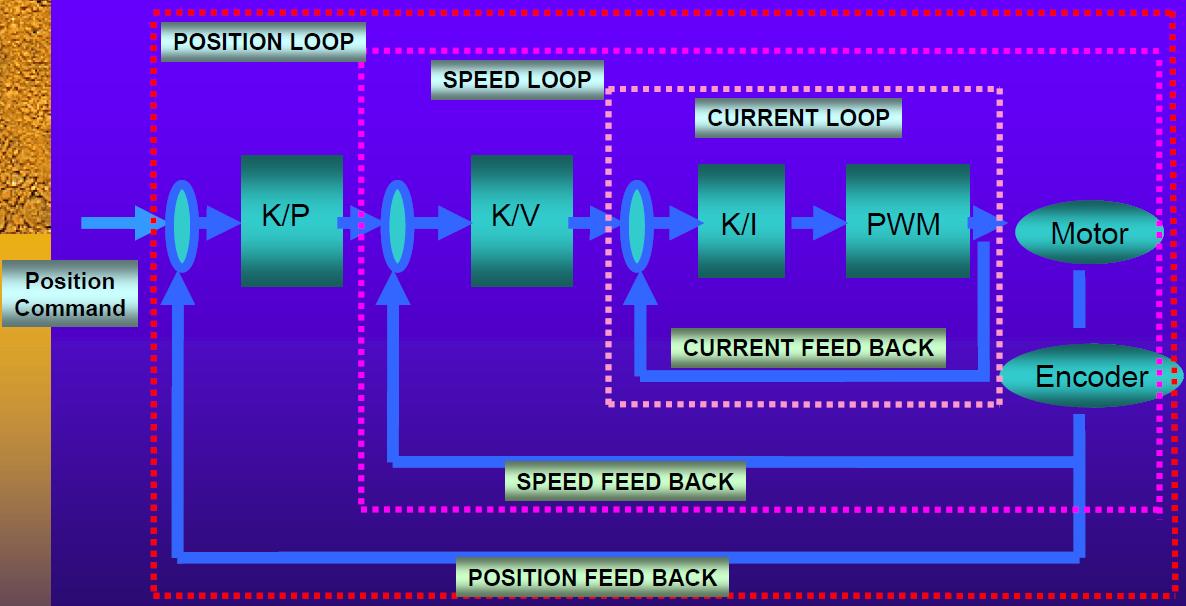Tytuł: sevo750W: Servo parameter adjustment methods
Wiadomość wysłana przez: markcomp Maja 07, 2010, 04:39:01
(http://www.markcomp77.p9.pl/img/servo_motor_ac_750W-m.jpg)
Servo parameter adjustment methods

Schematic
diagram of AC servo system
Servo driver parameter adjustment theory foundation
Servo driver has three feedback loops which are Position loop, speed loop and current loop. Current loop has the highest responsiveness. Meanwhile, speed loop must have a higher responsiveness than position loop.
If we do not abide by this principle, the motor will be caused to vibration or undesired reaction. While designing the servo drive, producer has ensured the highest responsiveness of speed loop. Therefore, users only need to adjust the gain of position and speed loop.
Generally speaking, the responsiveness of position loop cannot be faster than speed loop. Hence, it is strongly recommended to increase the gain of speed loop first, when you want to increase the gain of position loop. In case you only increase the gain of position loop, the motor is likely caused to vibrate. This in turn will cause the increase of speed reference and positioning time rather than desired decrease.
Note: The gain of position loop cannot exceed the natural frequency of mechanical system. Or, it will cause to vibration.
In case there is a need of high responsiveness of the whole system, You must not only ensure the high responsiveness of servo system (controller, servo drive, servo motor and encoder) but high robustness of the mechanical system as well. This way, the whole system can achieve good robustness.
Servo drive key parameter adjustment principle
Speed loop gain(Pn013) Speed loop gain is mainly used to decide the responsiveness of speed loop. Under the precondition of no vibration of mechanical system, the bigger the value of this parameter is, the higher the responsiveness is.
Under the strict precondition that setting value of the load inertia ratio is within the permission range, speed loop gain can reach designed value range. It, Consequently, ensures the high responsiveness of speed loop.
Increase the ratio of speed loop gain can enhance the robustness of servo system. However, in real application, the ratio of speed loop gain cannot be too large. Otherwise, it will cause the whole servo system to vibrate.
Speed loop integration time constant (Pn014) Speed loop integration can reduce the ripple of motor speed. However, it will also reduce the responsiveness of servo drive. Speed loop integration won’t affect speed tracing positioning reference, however too large a speed loop integration time constant will reduce the speed loop responsiveness. Therefore, when increase the time constant, the drive’s reaction time will be slowed and it needs more time for positioning.
When the load inertia is high or mechanical system is likely to vibrate, it is strongly recommended to increase speed loop integration time constant. Reference as follows:

Kv: speed loop gain [HZ]
Position loop gain(Pn015) Position loop gain is one of the fundamental index of AC servo system and has close relation to servo motor & mechanical load. Generally speaking, higher position loop gain will cause:
- Higher responsiveness of motor speed
- Smaller position tracing error
- Shorter positioning time
Torque reference filter time constant (Pn018) The mechanical system may cause sharp noise due to torque sympathetic vibration in some occasions. Increase torque reference filter time constant can reduce or eliminate the vibration noise.
However, like integration time constant, it will reduce the responsiveness of the whole system. Therefore, do not set the value of this parameter too large.
Reference adjustment methods as follows:
- Set position loop gain at a relatively lower value. Then under the precondition that it won’t occur abnormal noise & vibration, increase the speed loop gain to maximization step by step.
- Decrease the speed loop gain value step by step while increase the position loop gain. Under the precondition that no responsiveness over-adjustment & vibration, maximize the position loop gain.
- Speed loop integration time constant is decided by positioning time. Please minimized this value under the precondition that mechanical system no vibration.
- Consequently, optimize position loop gain, speed loop gain and speed loop integration time constant by minor adjustment step by step.
Tytuł: Odp: sevo750W: Servo parameter adjustment methods
Wiadomość wysłana przez: markcomp Lutego 09, 2011, 02:04:59
(http://markcomp77.p9.pl/img/servo/servo-pcd800.png)
1.
Set position loop gain (Pn015) at a relatively lower value. Then under the precondition that it won’t occur abnormal noise & vibration, increase the speed loop gain (Pn013) to maximization step by step.
2.
Decrease the speed loop gain value (Pn013) step by step while increase the position loop gain (Pn015). Under the precondition that no responsiveness over-adjustment & vibration, maximize the position loop gain (Pn015).
3.
Speed loop integration time constant (Pn014) is decided by positioning time. Please minimized this value under the precondition that mechanical system no vibration.
4.
Consequently, optimize position loop gain (Pn015), speed loop gain (Pn013) and speed loop integration time constant (Pn014) by minor adjustment step by step.
Tytuł: dostrajanie serva
Wiadomość wysłana przez: markcomp Lutego 09, 2011, 02:30:10
(http://markcomp77.p9.pl/img/servo/servo-pcd800.png)
1.
Ustaw Pn015 (wzmocnienie pętli pozycjonowania) na relatywnie małą wartość.
Zwiększaj Pn013 (wzmocnienie pętli prędkości), do momentu uzyskania niestabilnej pracy (rezonans/oscylacja)
2.
Zmniejszaj Pn013 (wzmocnienie pętli prędkości), kroko po kroku wraz ze zwiększaniem Pn015 (wzmocnienie pętli pozycjonowania). <<- pod warunkiem braku znaków niestabilnej pracy (oscylacje itp) Pn015
3.
Pn014 (stała czasowa integracji pętli prędkości) zmniejszaj do momentu niestabilności (wibracji itp)
4.
na koniec...
optymalizuj wartość Pn015, Pn013 i Pn014 przez malutki zmiany krok po kroku...
Tytuł: Odp: sevo750W: Servo parameter adjustment methods
Wiadomość wysłana przez: markcomp Grudnia 12, 2011, 10:38:23
zmniejsz Pn015 do 10, potem zwiększ Pn013 krokowo aż uzyska się wibracje - przy małych ale szybkich ruchach silnika... potem na powrót aż szumy (drgania, oscylacje) zanikną, następnie zwiększaj Pn015 do momentu uzyskania akceptowalnej odpowiedzi, bez "przeregulowania" i przy zachowaniu poprawnej pozycji...
następnie powtórz procedurę dla małych powolnych ruchów silnika...
itd...